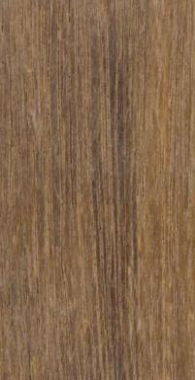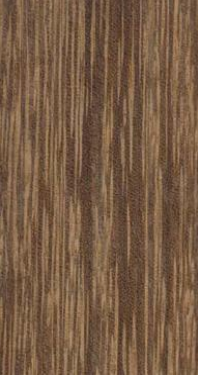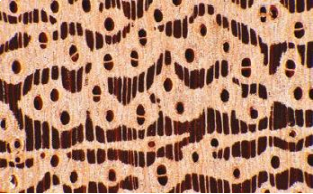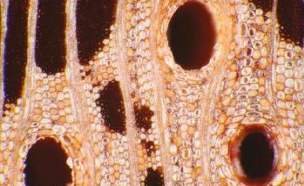Tatabu
| Family | Leguminosae (Fabaceae) |
| Botanical Names | Diplotropis martiusii |
| Continent | Latin America |
| CITES | (Washington convention of 2017)
No trade Restrictions |
| Diameter | 40 to 60 cm |
| Thickness of Sapwood | 1 – 2 cm |
| Buoyancy | Does not float |
| Log Conservation | Moderate (treatment recommended) |
Wood Description
| Reference colour | Sapwood | Texture | Grain | Interlocked grain | Notes |
|---|---|---|---|---|---|
| Dark brown | Clearly demarcated | Medium | Straight | Straight or interlocked | Wood dark brown to reddish brown with lighter thin veins |
Flat Sawn

Quarter Sawn

Physical and Mechanical properties
| Property | Mean Value |
|---|---|
| Density* | 0.91 |
| Monnin hardness* | 9.4 |
| Coefficient of volumetric shrinkage | 0.61 % per % |
| Total tangential shrinkage (Ts) | 7.0 % |
| Total Radial shrinkage (Rs) | 4.9 % |
| T/R anisotropy ratio | 1.4 |
| Fibre Saturation point | 24 % |
| Thermal conductivity | 0.29 W/(m.K.) |
| Lower heating value | 19,490 kJ/kg |
| Crushing strength* | 88 MPa |
| Static bending strength* | 141 MPa |
| Longitudinal modulus elasticity* | 22,300 MPa |
Natural durability & Treatability
| Resistance to decay | Class 2 – durable |
| Resistance to dry wood borers | Class D – durable (sapwood demarcated, risk limited sapwood) |
| Resistance to termites | Class D – Durable |
| Treatability | Class 3 – poorly treatable |
| Use class covered by natural durability | Class 3 – not in ground contact, outside |
Notes
According to the European standard NF EN 335 of May 2013, performance length might be modified by conditions in which it is used
Preservation Treatment
| Against dry wood borer attacks. | This wood does not require any preservation treatment. |
| In case of temporary humidification | This wood does not require any preservation treatment |
| In case of permanent humidification | Use of this wood is not recommended |
Sawing and Machining
| Blunting effect | Fairly high |
| Tooth for sawing | Stellite tipped |
| Machining tools | Tungsten carbide |
| Suitability for peeling | Not recommended or without interest |
| Suitability for slicing | good |
| Notes | Sometimes difficulties with sawing and machining due to interlocked grain. Good finish with filling |
Drying
| Drying rate | Normal to slow |
| Risk of distortion | Slight risk |
| Risk of case hardening | No known specific risk |
| Risk of checking | Slight risk |
| Risk of collapse | No known specific risk |
| Notes | must be dried slowly to prevent defects. A period of air drying prior to kiln drying is recommended |
| Suggested drying schedule | Schedule # 7 |
Assembling
| Nailing/ Screwing | Good but pre – boring necessary. |
| Notes | High specific gravity: important that gluing be performed in compliance with the code of practice and instructions for the glue used. |
Cross sections of Chlorocardium rodei


Commercial Grading
Sawn timber appearance grading
According to NHLA grading rules (2015) Possible grading: FAS, Select, Common 1, Common 2, Common 3. In French Guiana, the local name of this species is "COEUR DEHORS". Grading is done according to local rules "Bois guyanais classés". Possible grading: Choice 1, choice2, choice 3, choice 4
Fire Safety
| Conventional French grading | Thickness > 14 mm: M3 (moderately inflammable)
Thickness < 14 mm: M4 (easily inflammable) |
| Euroclass grading | D-s2, d0
Default grading for solid wood that meets requirements of European standard NF EN 14081-1 (April 2016): structural graded timber in vertical uses and ceilings with minimal mean density of 0.35 and minimal thickness of 22 mm. |
Main End uses
- Turned goods
- Heavy carpentar
- Ship building ( planking and deck )
- Cabinetry (high- en furniture )
- Stairs (inside)
- Vehicle or container flooring
- Panelling
- Exterior joinery
- Interior joinery
- Flooring
- Sliced Veneer
- House framing
Notes
Wood in high demand for deluxe en uses